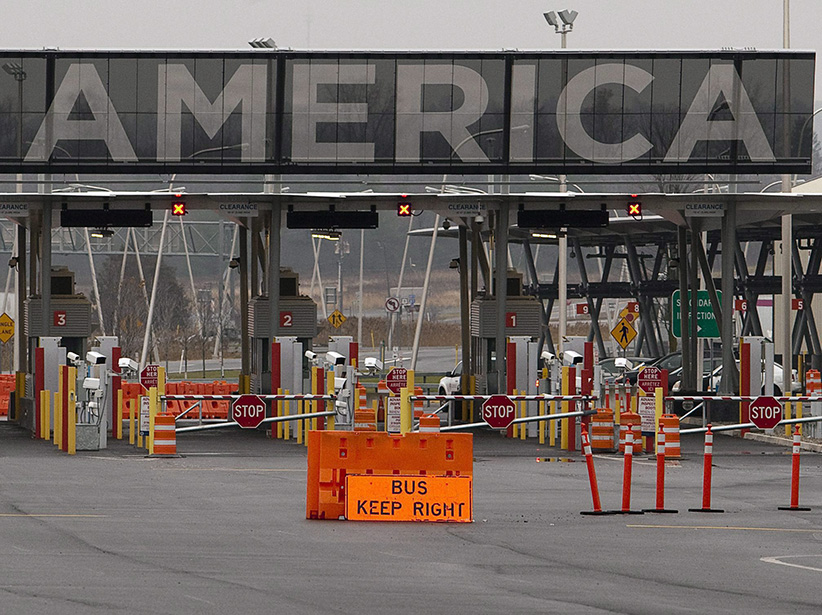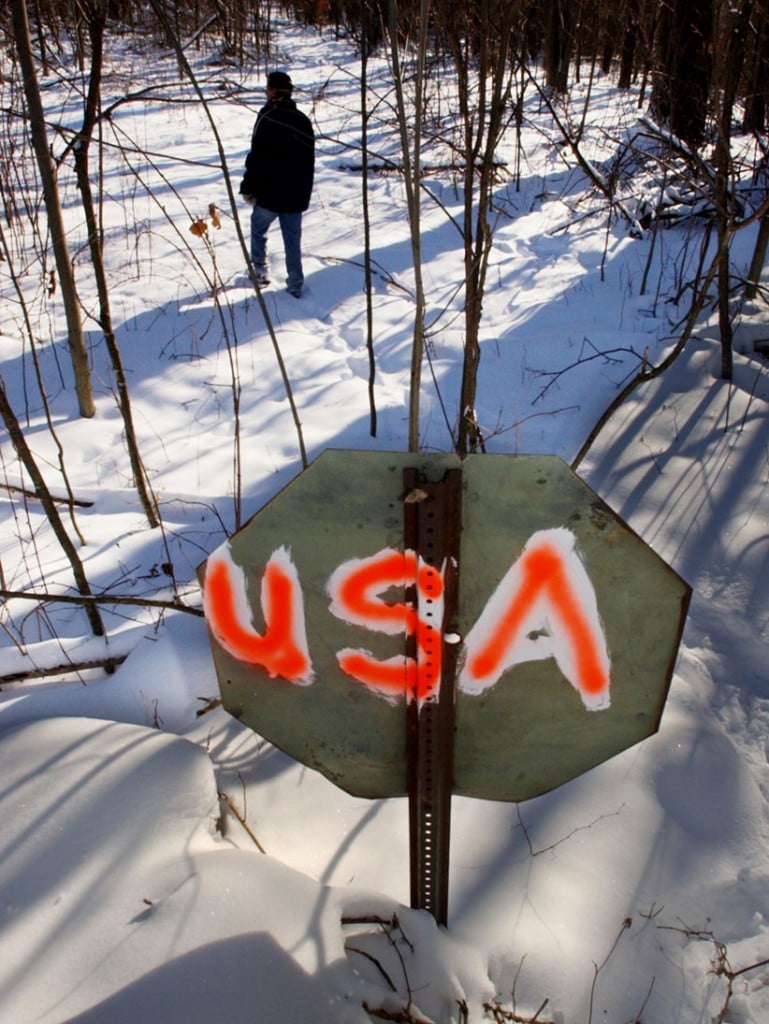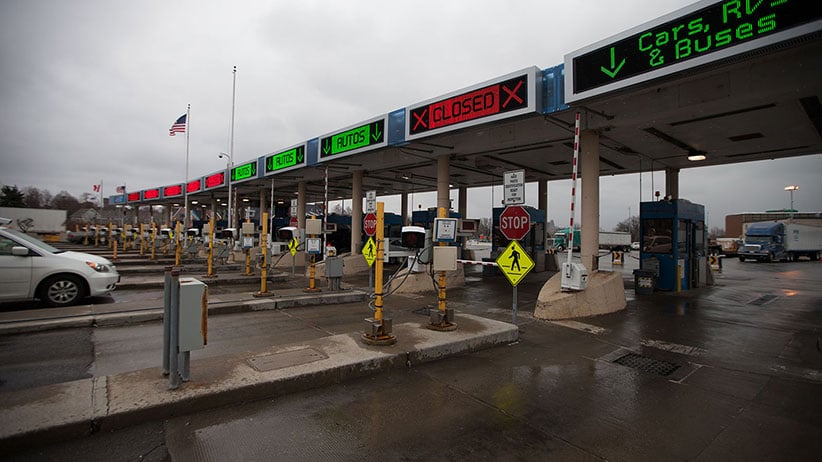The juicy target of America’s culture of fear: Canada
A fearful America looks nervously at its northern border
This makeshift sign marks the border between Quebec and New York State in an isolated area just south of the hamlet of Powers Court, Quebec. (Ken Faught/Toronto Star/Getty Images)
Share

Diane Bolden of Detroit gazed across the shimmering strait. Behind her was a terrorized republic and in front of her, just a short swim away yet immured in its own precious sovereignty, was a city in a completely different country: Windsor, Ont. Absent a new passport that she said she couldn’t afford, the American could only dream.
“What do you see when you look at Canada?” the retired Target cashier was asked. “Peaceful calmness,” Bolden replied. “I can’t wait to get over there.”
“It is just wonderful over there,” reported a former long-haul truck and bus driver named Dora Robertson, who hailed from a small town in Mississippi before moving up to the Motor City. “In Canada, there’s no harassment. When I won $9,000 on bingo in Windsor, they let me keep all my money. On this side, the IRS knows me!”
The women were standing beneath the Gateway to Freedom, a monument to the Underground Railroad that conveyed thousands of fugitive slaves to Victoria’s enlightened Dominion. For nearly a century and a half, since Confederation and the end of the War Between the States, the international boundary that bisected the Detroit River—and the continent from the Atlantic to Alaska —had been this planet’s nonpareil of pacific coexistence and bountiful trade. But now that comity was being lost in a fog of fear wafting up (or, in Windsor-Detroit’s case, down) from the U.S. side.
“President Barack Obama and Congress should immediately deploy the National Guard and military troops to patrol the U.S. southern border as well as designated spots along the northern border,” declared Dr. Ben Carson, candidate for the Republican nomination for president, in December.
“Canada—land of snowboarding prime ministers and cold-weather sports—is generally not known as a terrorist haven,” snuffed the Washington Post. “The border that terrorists are most likely to cross into the United States is not the one with Mexico, but Canada,” countered the Daily Beast in an article headlined “Canada’s growing jihadi cancer.”
“We need to look closely at our northern border,” argued one member of the House of Representatives in a private conversation with Maclean’s, stroking an old canard. “The 9/11 hijackers came through Canada.”
“So many foolish people that refuse to acknowledge the tremendous danger and uncertainty of certain people coming into U.S.,” tweeted Donald Trump.
“Trump taps into growing support for Fortress America,” reported a respected Washington newspaper, The Hill.
Even before the rampage in Paris, nervous glances were being cast northward from Washington toward the great unguarded—at least in many American minds —frontier. Legislation was introduced in the United States Congress under the sponsorship of members of both the Democratic and Republican parties. It read as follows:
IN THE SENATE OF THE UNITED STATES
AN ACT
(a) In General.—Not later than 180 days after the date of the enactment of this Act, the Secretary of Homeland Security shall submit to the appropriate congressional committees a Northern Border threat analysis that includes—
(1) current and potential terrorism and criminal threats posed by individuals and organized groups seeking to—
(A) enter the United States through the Northern Border; or
(B) exploit border vulnerabilities along the Northern Border;
(2) improvements needed at and between ports of entry along the Northern Border to—
(A) prevent terrorists and instruments of terror from entering the United States.

One of the act’s co-sponsors was Sen. Susan Collins, Republican of Maine. One day in December—after the massacre in San Bernardino, Calif. —Maclean’s asked Collins why she deemed it necessary to investigate the Canadian boundary as a potential source of carnage and horror. “Very little of the border we have with Canada is really patrolled,” Collins replied. “It is a vulnerability. A terrorist looking at where our resources are deployed would be much more likely to look at the border with Canada.” The senior senator from the Pine Tree State caught herself in mid-sentence. “Not ‘much more likely,’ ” Collins said. “Just ‘likely.’ But I also don’t want to create a situation where the hundreds of Mainers who cross into Canada every day and the hundreds of Canadians who cross into Maine every day face any obstacles. At one point, when it was being proposed that a passport had to be held, even by every child crossing the border, I kept thinking about my own family. One of my sisters-in-law is Canadian, and she has four children. Were they all going to have to get passports to be able to visit me?”
“Canada is accepting tens of thousands of Syrian refugees,” this reporter noted. “Do you think this is a threat to the security of the United States?”
“It depends on how they are vetted,” the senator responded. “It depends on who they are. At least we know that they are being vetted.”
“Do you trust Canada’s system of vetting refugees?’ Maclean’s asked Sen. Al Franken, Democrat of Minnesota. “I trust our system of vetting refugees,” Franken answered. “If the Canadian system is anything like ours, then I trust it, too.”
“At least when people land at an airport in Canada, there is a process that they go through,” said Sen. John McCain, Republican of Arizona. “If you fly into Guatemala or El Salvador or Honduras or some of these other countries, it’s completely non-existent. In light of San Bernardino, we need to review all of our security policies along both our borders,” McCain continued. “But I want to be very clear that we welcome all the Canadians who spend the winter in Arizona, and when the Coyotes are playing the Edmonton Oilers, they cheer for goddamn Edmonton.”
“We are a country of 330 million people,” New York City Police Department Commissioner William Bratton told Maclean’s in mid-December. “Since 9/11, 45 people have been killed in this country in terrorist acts. If people want to be afraid of something, they should be afraid of shootings, stabbings, ordinary crime. Politicians are stoking fears to new levels. It’s not just Donald Trump—several of the candidates are doing it.”
Republican candidate Chris Christie, governor of New Jersey, heedless of the commissioner’s soothing math, told a town hall last year: “FedEx can tell you where a package is, when it’s on the truck, when it’s at the station, when it’s on the airplane, yet we let people come into this country with visas and we don’t know where they are.”
“People aren’t packages,” noted Theresa Cardinal Brown. Brown is the former director of Canadian affairs at the U.S. Department of Homeland Security (DHS), a former attaché at the U.S. embassy in Ottawa, a scholar at the Bipartisan Policy Center in Washington, and the wife of a guy from Sault Ste. Marie, Ont. “Whenever we are in a period of generalized fear,” she said, “any rational assessment of fear goes out the window and we tend to look at all areas of risk as equal. The border isn’t necessarily the place where we should be looking. A straight line on the map is obvious, but we need to be working inside and around that line.”
“Americans should be concerned because it’s a pretty big border and it’s another vulnerability that we have,” said Matt Mayer, a visiting fellow at the American Enterprise Institute and a former DHS official. “Canada has been subject to Islamist jihadi attacks as well, so they know this is a problem. Canadians should acknowledge that they’ve had an experience with terrorism too, so it is in their interest to be as sure as they can be.”
“Should Canadians be concerned about a terror threat coming up from the United States?” Mayer was asked.
“Fortunately for Canada, America is such a target for Islamist jihadists that they’re probably not going to leave once they get here,” he replied. “There’s probably a bigger criminal network of maple syrup smugglers across the border than terrorists.”
“Your RCMP is very intelligent, savvy and hip,” said Henry Morgenstern, a security consultant based in Miami, the publisher of The Counter Terrorist magazine and the husband of a Canadian whose parents came to Toronto as refugees from Hungary in 1956.
“They’ve been very successful at tailing these people up to this point, but Canada has this culture of a welcoming attitude that makes me feel like a voice from the future. I don’t want to scare them like a canary in a coal mine, but when you see an attack like San Bernardino or the one on the Parliament in Ottawa, that kind of thing can destroy the mind of a country.
“Being an Israeli-American, I don’t know how you deal with a border that size, even technologically,” he adds. “I don’t know where the budget comes from. A terrorist group has a big advantage—they choose the place, time and method, and they have those choices all to themselves.”

Despite Obama’s assertion that “freedom is more powerful than fear,” no public place in America now feels safe, be it from Islamic State-inspired massacre or from a blank-eyed loner with a backpack full of guns. The jihadists may not be able to slaughter everyone, everywhere, but they certainly have proved their ability and desire to kill anyone, anywhere.
“We all have a fear of death,” reasoned Allyson Faith Shortle, an expert in political psychology at the University of Oklahoma. “In certain situations, you are going to think about your own mortality more than others. People act differently in response to fear appeals, but when you add terrorist events on top of that, you get this fear that their American way of life is going to be destroyed. I think there is quite a fear when you’re talking about the Canadian border. There is this idea that terrorists do come through unsuspected channels from Canada and Mexico, and so we see this tendency to want to lock the nation down.”
It was in Oklahoma, of course, where the worst politically motivated domestic attack in U.S. history was committed by a white Christian—the bombing of a federal office building in Oklahoma City in 1995 that killed 168 people, including 19 pre-schoolers.
“That’s just seen as random error,” Shortle said. “That’s just seen as a person who was mentally unstable. It’s different if the person involved is different from ‘us.’ ”
“TURN OFF THE BOAT! COME OUT ON DECK! PUT YOUR HANDS ON THE RAILING AND DON’T MOVE!” the Mountie commanded. Out of the wheelhouse skulked a man and a woman, squealing in protest.
“Vot is dis about?” the female demanded, in a Tina-Fey-in-Muppets–Most–Wanted accent.
“You are under arrest,” the gendarme explicated.
The captain and mate, who were being handcuffed by a joint raiding party of RCMP and U.S. Coast Guard members, were hired actors. Their watercraft was a dry-docked dory at the Federal Law Enforcement Training Center in North Charleston, S.C., a long way from Sarnia or Syria. The border-guarding boarders were candidates for the unique and creative “Shiprider” program that allows officers from the two nations to work together on the same patrol vessels in the rivers, lakes, straits, bays and seaways that divide Fortress America from its friendly neighbour to the north.
This was the real work of border protection, stripped of its Trumpian bombast, its Congressional “oversight” and the fears of citizens staring worriedly at lines on a map. Every day, officials said, Shipriders were seizing ecstasy and cocaine, enforcing maritime regulations and flying the flag of scrutiny over at least a few small sections of the unmilitarized—at least until a Ben Carson presidency—stripe.
In South Carolina, mucky-mucks from both countries were standing about the mock-up’s hull and watching the exercise. One of them was Gaétan Courchesne, chief superintendent of the RCMP for Quebec. “What we need to do is assure that we are vigilant and ready to act,” Courchesne told Maclean’s. “I don’t think we need to go overboard and create chaos.”
“There are a lot of misconceptions about the northern border,” said Joe Banco, the associate chief of the U.S. Border Patrol and a man whose former assignments included scouring the labyrinthine smuggler’s paradise of the Thousand Islands in the St. Lawrence River. “It’s not wide open with free access whether you’re going north or south. You may not see the Border Patrol or the RCMP every hundred yards like you do on the Mexican border, but we are using every technology we have.”
“Should Americans be concerned about the possibility of terrorists coming from Canada?” Banco was asked.
“Americans and Canadians should be concerned about the world we are living in together,” he answered.
“Why not erase the border and be done with all this?” a reporter wondered.
“Look what we’re seeing now in Europe, where borders were eliminated,” Banco answered. “Canada’s a unique country. We’re a unique country. We have to define where one country ends and the other begins.”
The border that ends Canada and begins the United States is 8,891 km long. Some of it is forested vastness, some of it is the Great Lakes, some of it is Arctic wilderness and one fraction of it cuts right through the Haskell Free Library and Opera House, whose stage is in Derby Line, Vt., and whose back rows are in Stanstead, Que.
“As kids growing up here, it was just one great big town,” said John Wilson, who is now the (non-partisan) president of the city council in Newport, Vt., just south of the border. “We would wave to customs officers and just walk through. But after 9/11, everything really tightened up. I guess you can never go back to the past.”
Newport sits at the southern end of Lake Memphremagog, most of which is in Quebec. The publisher of the Newport Daily Express is a man named Ken Wells. “This border right here is one of the least crossed,” Wells said by phone. “A lot of people here think that it’s over-fortified. Traffic is down, but there’s such a paranoia here these days that it’s almost overkill. I don’t know if you can ever have too much law enforcement, but in a place like Derby Line, how many police cruisers do we need? How many Border Patrol officers do we need?”
Half a century ago, John Wilson was working in a tool and die factory that was bisected by the international boundary—not that anyone cared much, back in those days. When the U.S. went to war in Southeast Asia, Wilson remembered, “seven or eight of the boys from the Canadian side all turned in their green cards and went back to Canada. I didn’t, and I was rewarded with a trip to Vietnam.”
Not long ago, Ken Wells’s newspaper reported that “Alarm signals briefly rang out on a quiet, sunny morning in the small village of Derby Line. Two illegal immigrants purportedly crossed the U.S./Canadian border through a clump of trees among the homes that line the border.”
“Rarely happens nowadays,” Ken Wells said.
“When we were young, it was all open, but not anymore,” John Wilson sighed. “They’ve got sensors and stuff all over the woods.”
“I guess all it takes is one person to get through to cross the border and cause havoc,” Wells said. “But every time this happens, that character Donald Trump goes up another few points.”
“The hard part is measuring success,” a man named Gregg Ward was saying. “Is not having a bomb go off a success?”
Ward was sailing aboard the Lac St.-Jean, the barge that serves as a ferry across the Detroit River for wind-power towers, bulk-form whisky carriers, manufactured homes and other cargo too long, wide or flammable to be hauled across the Ambassador Bridge. Ward and his father before him have commanded this one-boat navy since 1990. He laughed and bragged of using “4,000-year-old technology, barging across the river like Cleopatra. If they don’t cross with us,” he said, “they have to drive around the Great Lakes.”
Ward, an American, said he had heard about “threats to the transportation infrastructure,” and on this stretch of the border, the infrastructure was himself, a Canadian deckhand named Doug Pettit, a tugboat captain, and the good ship Lac St.-Jean.
“We live in 2015,” Ward said. “There are a lot of threats to the United States. We’ve been at war with the Middle East for a long time now. It doesn’t mean that they’re necessarily Canadian threats, but we have to maintain a security posture, and this is one of the places to do it.”
“The 9/11 terrorists accomplished what they set out to do,” deckhand Pettit said. “They wanted to make everyone afraid, and they did. Not just in the United States—worldwide. I can understand the need for security, but it can go too far. When there’s commerce, you’ve got to cut a little slack.”
On the Detroit River, in the halls of Congress and from Memphremagog to the Beaufort Sea, the mood for slack was waning at Christmas 2015. Searching for safety in an unsafe time, men and women huddled inside walls of their own minds’ making.
One of those barricades was an invisible line down the middle of a river. On an average day, Pettit crossed it 22 times, under the eagle eyes of Shipriders, helicopters, drones, sensors and more than 300 million worried souls of many citizenships.
On this day, at least, the weather was clear and the river strong, and evil seemed to be at bay.
“Are you a threat?” Pettit was asked. These days, you need to make sure.
“Only to myself,” the seaman replied.